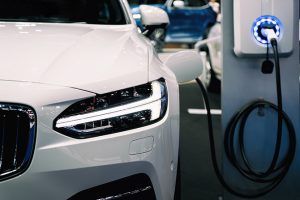Elon Musk recently commented that he couldn’t see his closest competitor in the EV market with a telescope.
Those are admittedly bold words, and that kind of posturing is typical as the jockeying within the EV market heats up. But many dealers selling OEM brands think Mr. Musk doesn’t need a telescope; he needs a mirror. And since objects in mirrors can be much closer than they appear, he should put down his telescope and turn around instead.
It’s true that from 2018–2020, approximately 80% of the EV market belonged to Tesla. But the market balance is shifting. It decreased to 71% in 2021 and 65% during the first nine months of 2022. The biggest market gains were for cars selling at less than $50,000. By 2025, experts like John Murphy, the Managing Director and Lead Auto Analyst at Bank of America Merrill Lynch, think Tesla’s market share will drop to the low teens.
Other companies have been working on more than a dozen new options that will start selling within the next year. Experienced and powerful competitors such as General Motors, Ford and Mercedes-Benz are actively competing with Tesla. Registration data on a national level shows that their work is being rewarded, and people are buying new EV models from manufacturers other than Tesla.
There’s a name for what Tesla has experienced: “first-mover advantage.” Michelle Craig, an Executive Analyst at Cox Automotive, said she always expected Tesla’s market share to go down at some point after the competition began to catch up with them. Tesla has revolutionized the auto industry by focusing on impressive battery power. Still, as she pointed out, people want the affordable, eco-friendly EVs that are starting to hit the market. They will appreciate the chance to buy those EVs from trusted manufacturers at a lower price than what Tesla currently offers. Tesla’s inadequate support system for auto repairs will also persuade customers to choose something other than a Tesla when they decide to buy or replace an EV.
Even though Tesla has been dropping its price on some vehicles and plans to offer at least one more-affordable option soon, that still doesn’t solve the company’s biggest weakness: being unable to repair its vehicles quickly. It also doesn’t erase the fact that other manufacturers will compete head-to-head on aspects such as equal or better technology and production build.
Legacy manufacturers have been preparing to capture market share in the EV race:
- Ford sold 61,575 vehicles in the U.S. in 2022 and now plans to meet the demand by doubling its production target. What do customers want to buy from Ford? Electric vans, Mustangs and trucks. Car and Driver magazine named Ford’s Mustang Mach-E model the 2021 “Electric Vehicle of the Year.” It was number three in sales of electric sport utility vehicles. Ford unveiled the F-150 Lightning in May 2022, then took 200,000 reservations. Three-fourths of them were buyers who had never bought a Ford before. According to a survey conducted by Cox Automotive, respondents preferred the Ford F-150 to Tesla’s Cybertruck. They chose the Ford F-150 because of its price, driving performance, size and design.
- Volkswagen is spending tens of billions to meet a goal: moving half its U.S. sales to EVs by 2030. The company plans to produce 1.5 million EVs by 2025 to meet new EU emission targets.
- Hyundai’s award-winning IONIQ 5 has been named the Best Electric Vehicle by Cars.com in its Best of 2023 Awards. The IONIQ 5 surpassed all the 2023 EVs in the market tested by the company’s editorial team of expert car reviewers.
Other manufacturers to consider are General Motors, Volvo and Xpeng. The Detroit Bureau expects a dozen or more all-electric pickups to be available by 2025. In addition to vehicles manufactured by Toyota, Hyundai and others, people will buy the Chevrolet Silverado EV, Ford’s F-150 Lightning, the GMC Hummer and Sierra SUV and the Ram 1500 EV.
Don’t discount Chinese companies like Nio and Xpeng, even though they seem too unfamiliar for Americans to worry about. Elon Musk has said he considers his biggest competitors to be Chinese automobile manufacturers, even though (characteristically) he thinks everyone is so far behind Tesla that they are a “distant second.” But despite Tesla having an advantage in its worldwide Supercharging network, Consumer Reports rates it seventh on Advanced Driver Assistance Systems. (The best Driver Assistance systems in the U.S. were Ford BlueCruise and GM SuperCruise.) Also, the German Level 3 system made by Mercedes-Benz surpasses Tesla’s Level 2 system.
Just how fast is the market for EVs growing? In 2011, manufacturers sold 45,000 vehicles globally. The number was 3.24 million in 2020. Experts think 27 million vehicles will be sold by 2030.
Tesla has done well financially. In 2012, annual sales were $400 million. They were $31.5 billion in 2020. However, maintaining that growth may prove impossible as other companies get involved and make the investments necessary to meet their goals. The drop in Tesla prices was good news for prospective owners but bad for existing owners. After all, there’s nothing quite like seeing the value of an expensive vehicle drop 20% in one day. In addition, Tesla vehicles have had construction problems and stale designs, and the federal government has been investigating 16 Tesla crashes that involved Autopilot or Traffic-Aware Cruise Control.
Having stores where people can bring their vehicles for service and repair is a big advantage for dealerships. Earthweb estimated 2.5 million Tesla vehicles on the road at the end of 2022. According to Electrek in an online article dated June 2022, Tesla had more than 673 stores and service centers and more than 1,372 mobile service vehicles. Although Elon Musk said about the same time that his goal was to improve service in North America, he hasn’t been able to close that gap adequately yet. The reality for many Tesla owners is that they might not be close to any service center or mobile service vehicle. Even if they are, they might have to wait weeks or months for service from an authorized center. Elon Musk hoped that Tesla vehicles would need so little service that the shortage of repair places would have been no problem, but it hasn’t worked out that way. For example, Tesla windshields crack like windshields in other cars, but nobody has them in stock for next-day repair.
Tesla’s inadequate service network creates an opportunity for its competitors. According to Mark Reuss, GM’s president, GM dealers started repairing Teslas in 2021. Other companies are doing the same thing. There’s even a website (fixyourtesla.com) with a national directory of third-party Tesla service shops.
The world is moving to electric vehicles, and that will change the automotive landscape, but Tesla doesn’t have a lock on what that future will be in terms of market share. Tesla benefited from U.S. prosperity and a lack of competition. Those days are done. Legacy vehicle manufacturers are finding ways to adopt Tesla’s best ideas without dismantling the dealership model that has been developed and proven over time.







